 |
Typical Landscapes
|
Bears, Birds, Botany, Ecology, Churchill
the Town,
Churchill
Northern Studies Centre,
Geology, Great Hudson Bay Dip and Relay Race, Landscapes, Practicalities, Tours, Whale
Watching,
Wildlife
Management Churchill Style/ Churchill's
main page
Nature's Rock Garden
An Early Foggy
Morning/ Stand
of Vetch/ Boreal Bog/ Hidden
Meadow/ November Shoreline/ Krumholtz
Formation in Whiteout/ Treeline/ Esker/ dryas/ spider
webs/ sunset/ July Ice/
Another Boreal Meadow
Click on each picture to view larger version
Say the word "tundra," and people
envision a vast wasteland of empty space where nothing grows but
lichen and reindeer moss, a bleak wasteland. Nothing could be
farther from the truth. Here, spring moves quickly into vigorous
summer. During late June through early August, nothing is dead
or colorless. Charlotte Seline Bompas (1830-1917), wife of the
first Bishop of Selkirk (Yukon), kept a journal that described
spring and summer in the far north. Churchill is very much like
this:
"The rapidity with which the summer comes
on here is quite wonderful. The ice only began to give way on
May 13, and at that time, of course, the snow lay thick everywhere
and by the end of the month the small gooseberry bushes were in
blossom ... every bush round seems to bear promise of berries,
and we walk on a carpet of wild strawberry blossoms. At a quarter
to ten in the evening, the sun sinks down almost in the same place
where it rises then follows out a long beautiful twilight. There
is really no night even now. And at two in the morning, the dawn
begins and birds chirp-one very like a thrush."
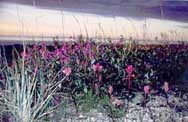 |
MacKenzie's Vetch growing in gravel overlooking Hudson
Bay.
The various soil types and environments support a wide variety
of plant types. These vetch are a common plant in July. One of
the most beautiful sights was a 2-3 acre stretch of land, completely
given over to these beautiful fuschia flowers in bloom.
|
|
Boreal Bog
Thank these for the huge and ravenous mosquito population.
Mosquitoes and other insects are the plankton of the land as
well as a huge annoyance to humans and other mammals. They feed
a variety of spiders, amphibians, fish, 150 species of birds
and probably some small animals. These in turn feed Gyrfalcons,
Arctic owls and other raptors, foxes, wolves,and other life forms.
They do not, however, figure prominently in the polar bear food
chain.
In the bogs are also found most of the local carnivorous plant
species.
|
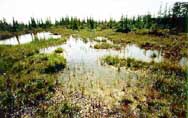 |
|
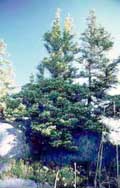 |
Hidden boreal meadow
There are a few places, protected by the wind, where the white
spruce trees retain the familiar christmas tree shape. Because
permafrost exists here, too, they only stand about five feet
high at the tallest. I climbed the rocks near "Twin Golfballs"
(Local nickname for an old landsat facility). Low green grasslike
vegetation covered the ground around the rocks, all dotted with
the jewelike blooms of Arctic Dryas and other species. The spiderwebs
up here here were MAGNIFICENT.
|
|
Hudson Bay shoreline in November
By then, the tender summer plants have gone dormant
or died. The evergreens, white spruce and larch, have turned
|
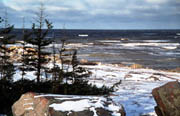 |
|
 |
Krumholtz Formation During Winter Whiteout
The fierce wind off Hudson Bay dries and kills branches on
the windward side, giving trees a flaglike appearance Intense
winter cold, combined with permafrost, dwarfs these trees as
it does every other plant.
|
|
Northern Treeline
The way these trees grow is described as "Krumholtz
formations." Trees are stunted, with flaglike tops due to
the wind and permafrost.
|
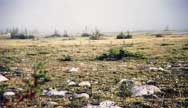 |
|
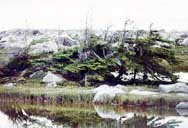 |
Overgrown glacier esker, overlooking a glacial
pond
Then the glaciers melted, they dropped piles of rocks and
other debris. This often took the form of mounds.
|
|
Arctic Dryas growing on the beach
Most of the major families of plants are represented in the
Arctic-Sub-Arctic Churchill region. Dryas is a member of the
Rose Family
|
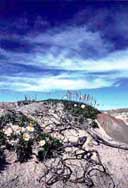 |
|
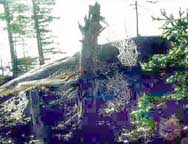 |
The Spider Webs are Magnificent!
Is it surprising that, in a region that swarms with millions
of mosquitoes, flies, no-see-ums, dragon flies, etc .etc. etc.
that spiders would be there? The spider webs up there are the
size of pillow cases.
|
|
View from a Hill
Panorama view of a beach overlooking Hudson Bay, just as the
sun began to set in early evening. Just beyond this point, the
road turns inland and away from shore. Many places along the
road are steep cliffs, dropping to rocks below. This view is
rather gentle.
|
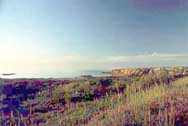 |
|
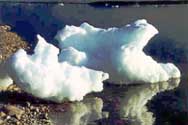 |
July Ice
The summertime weather gets up to about 75 F at its warmest,
and yet these small chunks of ice remained on the beach. In middle
to late July, there were still ice floes
further out.
|
|
Boreal Meadow
The black speck in the upper RH area is a mosquito! This picture
was taken about 9:00 pm after a brief but intense rainstorm.
|
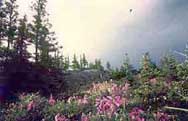 |
|
botany, Arctic botany, Churchill
Canada Botany, MacKenzie's vetch, boreal botany, Arctic dryas

